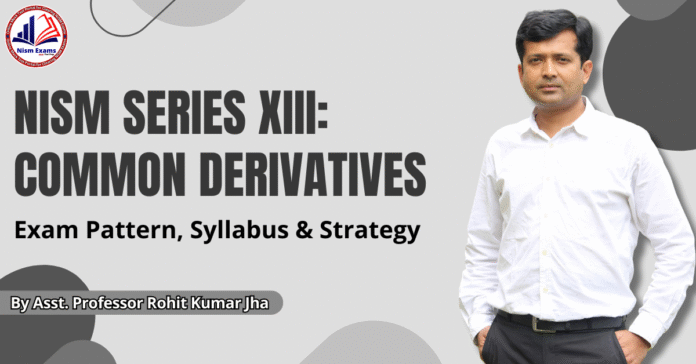In my 25 years as an educator, I have become very familiar with the feeling of panic. It’s the feeling that grips a student when they see the result of their very first full-length mock test. You have spent weeks, perhaps months, diligently studying the NISM workbook. You feel you have a good grasp of the concepts. And then, you take your first simulated exam, a NISM 13 Mock Test, and the score that flashes on the screen is nowhere near the 60% passing mark.
The immediate reaction is almost always the same: a sinking feeling in the pit of your stomach, a wave of self-doubt, and the overwhelming question, “Can I even do this?”
If this has just happened to you, I want you to stop, take a deep breath, and listen to me very carefully. A low score on your first mock test is not a sign of impending failure. In fact, if you approach it correctly, it is the single most valuable event in your entire preparation journey. It is not a verdict; it is a diagnosis. It is a roadmap that is showing you exactly what you need to do to succeed.
The problem is that most students don’t know how to read this roadmap. They either get demotivated and give up, or they continue studying without a clear strategy, hoping for a different result. Hope is not a strategy. A plan is a strategy.
In this guide, I want to give you that plan. We are going to take your low mock test score and use it as the foundation for a powerful, 4-week recovery plan that will systematically turn your weaknesses into strengths and put you on a confident path to clearing the NISM Series XIII exam.
- The Golden Rule: Reframe Your Score from a Verdict to a Diagnostic Report
The first and most important step is a psychological one. You must stop seeing your low score as a failure. A mock test is not the final exam. Its purpose is not to judge you; its purpose is to guide you.
Think of it like a blood test report from a doctor. If the report shows a vitamin deficiency, you don’t panic and assume your health is doomed. You see it as valuable information. The doctor now knows exactly which supplement to prescribe. Your low mock test score is that blood test. It is a detailed, data-driven diagnostic report of your preparation’s health. It is showing you, with pinpoint accuracy, your “vitamin deficiencies.” Our entire recovery plan will be based on treating these specific deficiencies.
- The 4-Week Recovery Plan: From Diagnosis to Dominance
Now that we have the right mindset, let’s get to the actionable plan. This is a week-by-week blueprint.
Week 1: The Deep Dive – Diagnosis and Foundational Repair
The goal of this week is to thoroughly analyse your “diagnostic report” (your first mock test result) and repair the foundational cracks it has revealed.
Step 1: The Granular Analysis (First 2 Days)
Do not just look at your overall score. A good NISM XIII Model Test will provide you with a detailed, section-wise and chapter-wise breakdown of your performance. You need to create a simple “Error Analysis” sheet.
- Identify Your Weakest Module: The NISM XIII covers Equity, Currency, and Interest Rate derivatives. Which of these three was your lowest-scoring section?
- Pinpoint the Weakest Chapters: Within that weak module, which specific chapters did you score poorly in? Be brutally honest. Was it Option Strategies? Bond Pricing? Currency Hedging calculations?
- Categorise Your Errors: For every question you got wrong, categorise the error. Was it:
- A Conceptual Error (you just didn’t understand the underlying concept)?
- A Calculation Error (you knew the formula but made a silly mistake)?
- A Misreading Error (you misread the question or the options)?
Real-World Example: Anjali’s Analysis
Let’s take a student, Anjali. She scored 35% on her first NISM XIII Practice Test. Instead of panicking, she spent a day analysing the results. She found that:
- Her weakest module was Interest Rate Derivatives, where she scored only 20%.
- Within that, her weakest chapters were Bond Pricing and Duration.
- Most of her errors were conceptual. She simply did not have a clear understanding of the inverse relationship between bond prices and yields.
Step 2: Foundational Repair (Next 5 Days)
Now that Anjali knows her exact deficiency is “Bond Pricing and Duration,” she spends the rest of the week on focused repair. She does NOT touch the modules she is already good at.
- She re-reads only those specific chapters from the official NISM workbook.
- She watches video lectures specifically on these topics.
- She creates concise notes and a formula sheet only for these concepts.
By the end of Week 1, you will not have studied everything, but you will have repaired the biggest cracks in your foundation.
Week 2: The Targeted Attack – Chapter-Wise Mastery
The goal of this week is to build your strength and confidence in your identified weak areas through targeted practice.
This is where you move from passive reading to active problem-solving. You should now attempt chapter-wise practice tests or quizzes that focus exclusively on the chapters you identified in Week 1. This is a crucial step before you attempt another full-length NISM Common Derivative Mock Test.
For Anjali, this would mean spending the entire week doing practice questions only on Bond Pricing and Duration. The goal is to solve so many problems on these topics that the concepts and formulas become second nature. This targeted attack turns a weak area into a potential strength.
Week 3: The Integration Phase – Strategy and Simulation
You have repaired your foundation and practiced your weak areas. Now it is time to put it all together and work on your exam-taking strategy.
Step 1: The Second Mock Test (First Day of the Week)
At the beginning of Week 3, you should take your second full-length mock test. This is a critical milestone. Do not be afraid. You have worked strategically for two weeks, and you will almost certainly see a significant improvement in your score. This will be a massive confidence booster.
Step 2: Focus on Exam Strategy (Rest of the Week)
Your analysis of this second mock test should be different. You are no longer just looking for knowledge gaps. You are now looking for strategy gaps.
- Time Management: Did you manage to complete the paper? Which section took up the most time? This is where you start practicing the Three-Pass Strategy (Easy Wins -> Thinkers -> Strategists).
- Negative Marking: How many marks did you lose to incorrect answers? This is where you start consciously applying the Educated Guess Framework (only guess if you can eliminate two options).
This week is about learning how to take the test. A NISM 13 Demo Test can be a good, quick tool to practice these strategies on a smaller set of questions.
Week 4: The Final Rehearsal – Building Peak Confidence
The final week is all about building a peak state of confidence and familiarity, so you can walk into the exam hall feeling prepared and in control.
- Final Mock Tests: This week, you should aim to take at least two or three more full-length mock tests. The goal now is to consistently score above the 60% passing mark. Every time you do, your self-belief solidifies.
- Revise Your Notes: Spend the last few days revising your own concise notes and formula sheets. Do not go back to the thick workbooks.
- Relax and Prepare: The day before the exam should be about relaxation and logistical preparation, not frantic cramming.
- Conclusion: Trust the Process, Not the Panic
A low score on your first mock test is a moment of truth. It can be a moment of panic that spirals into self-doubt, or it can be the starting point of a smart, strategic, and ultimately successful preparation journey.
The key is to use a mock test that gives you detailed, chapter-wise analytics. A quality NISM Series XIII: Common Derivative Certification Mock Test will not just give you a score; it will give you a roadmap. It is the first step in your recovery and the foundation of your success.
Trust the data from your mock test. Trust the process of this 4-week plan. And most importantly, trust in your ability to learn, adapt, and improve.
Frequently Asked Questions (FAQs)
- Is a low score on my first NISM XIII mock test a sign that I will fail the exam?
Absolutely not. The blog strongly argues that a low score on your first mock test should be viewed as a valuable “diagnostic report,” not as a verdict of failure. It is a tool that provides a clear and honest roadmap of your strengths and weaknesses, which is the essential first step to creating a successful study plan.
- What is the very first thing I should do after getting a low mock test score?
The first and most important step is a psychological one: reframe the narrative. You must stop seeing the score as a failure and start seeing it as a guide. The next practical step is to conduct a granular analysis of your results to identify your weakest modules and chapters.
- What is the “Error Analysis” process recommended in the blog?
The “Error Analysis” is a deep dive into your mock test results. It involves:
- Identifying your weakest module (Equity, Currency, or Interest Rate Derivatives).
- Pinpointing the specific chapters within that module where you scored poorly.
- Categorising each wrong answer as a Conceptual Error, Calculation Error, or Misreading Error to understand the root cause of your mistakes.
- The recovery plan is for 4 weeks. What should be my primary focus in Week 1?
The primary focus of Week 1 is Diagnosis and Foundational Repair. According to the article, you should spend this week analysing your first mock test result in detail and then going back to the official NISM workbook and other study materials to re-learn and strengthen the specific chapters where you have a conceptual weakness.
- How does the strategy change in Week 2 of the recovery plan?
In Week 2, the focus shifts from passive learning to active, targeted practice. The blog advises that you should attempt chapter-wise practice tests and quizzes that focus exclusively on the weak areas you identified in Week 1. This helps to build mastery and confidence in those specific topics.
- When should I take my second full-length NISM 13 Model Test?
The plan recommends taking your second full-length NISM XIII Model Test at the beginning of Week 3. This acts as a milestone to measure your improvement after two weeks of focused effort and helps to shift your focus from knowledge gaps to strategy gaps (like time management).
- The article mentions a “Three-Pass Strategy.” What is it?
This is a time management technique for the exam day. It involves:
- Pass 1: Quickly answering all the easy questions you are 100% sure about.
- Pass 2: Attempting the more time-consuming or calculation-based questions.
- Pass 3: Tackling the most difficult questions and making strategic decisions about the negative marking.
- Why is it important to use a NISM XIII Mock Test that provides detailed analytics?
The entire recovery plan is built on the idea of using the mock test as a diagnostic tool. A mock test that only gives you an overall score is not useful. The blog emphasizes that you need a quality test that provides a detailed, chapter-wise breakdown of your performance, as this is the data that will guide your entire study plan.
- What is the main goal of the final week (Week 4) of the plan?
The main goal of Week 4 is to build peak confidence and familiarity. This is achieved by taking two or three final full-length mock tests to consistently score above the passing mark, revising your concise notes, and getting mentally and logistically prepared for the exam day.
- What is the single most important message of this blog for a student who is feeling demotivated?
The single most important message is to “Trust the Process, Not the Panic.” A low mock test score is a common and even valuable part of the preparation journey. The key is to not get discouraged, but to use that score as data to create a structured, strategic recovery plan and work through it with discipline.








































